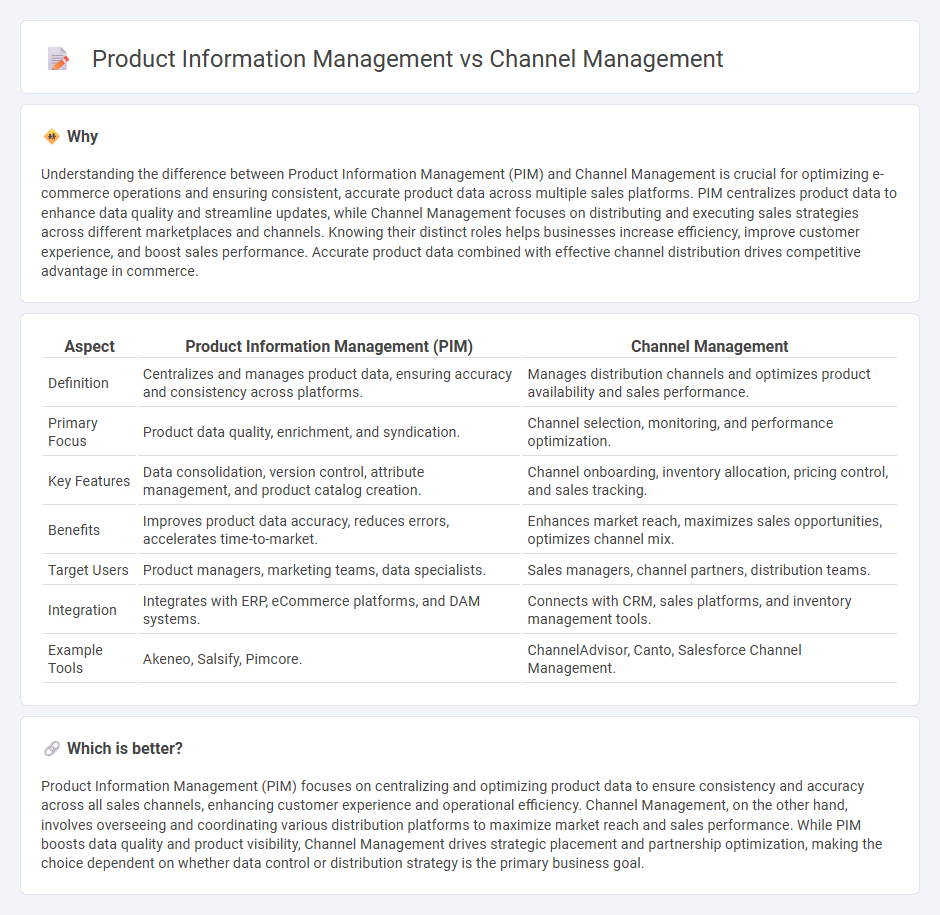
Product Information Management (PIM) centralizes and streamlines product data to ensure accuracy and consistency across all sales channels. Channel Management focuses on optimizing the distribution and marketing strategies for products across multiple platforms and retail outlets. Explore the key differences and benefits of each approach to enhance your commerce strategy.
Why it is important
Understanding the difference between Product Information Management (PIM) and Channel Management is crucial for optimizing e-commerce operations and ensuring consistent, accurate product data across multiple sales platforms. PIM centralizes product data to enhance data quality and streamline updates, while Channel Management focuses on distributing and executing sales strategies across different marketplaces and channels. Knowing their distinct roles helps businesses increase efficiency, improve customer experience, and boost sales performance. Accurate product data combined with effective channel distribution drives competitive advantage in commerce.
Comparison Table
| Aspect | Product Information Management (PIM) | Channel Management |
|---|---|---|
| Definition | Centralizes and manages product data, ensuring accuracy and consistency across platforms. | Manages distribution channels and optimizes product availability and sales performance. |
| Primary Focus | Product data quality, enrichment, and syndication. | Channel selection, monitoring, and performance optimization. |
| Key Features | Data consolidation, version control, attribute management, and product catalog creation. | Channel onboarding, inventory allocation, pricing control, and sales tracking. |
| Benefits | Improves product data accuracy, reduces errors, accelerates time-to-market. | Enhances market reach, maximizes sales opportunities, optimizes channel mix. |
| Target Users | Product managers, marketing teams, data specialists. | Sales managers, channel partners, distribution teams. |
| Integration | Integrates with ERP, eCommerce platforms, and DAM systems. | Connects with CRM, sales platforms, and inventory management tools. |
| Example Tools | Akeneo, Salsify, Pimcore. | ChannelAdvisor, Canto, Salesforce Channel Management. |
Which is better?
Product Information Management (PIM) focuses on centralizing and optimizing product data to ensure consistency and accuracy across all sales channels, enhancing customer experience and operational efficiency. Channel Management, on the other hand, involves overseeing and coordinating various distribution platforms to maximize market reach and sales performance. While PIM boosts data quality and product visibility, Channel Management drives strategic placement and partnership optimization, making the choice dependent on whether data control or distribution strategy is the primary business goal.
Connection
Product information management (PIM) centralizes and organizes product data, ensuring accuracy and consistency across multiple sales channels. Channel management relies on this clean, structured product information to optimize listings, pricing, and promotions tailored to each platform. Synchronizing PIM with channel management enhances customer experience and drives sales by maintaining up-to-date and coherent product details everywhere.
Key Terms
Distribution channels
Channel management optimizes the processes and strategies for distributing products through various sales avenues, ensuring efficient reach and customer engagement across retail, online, and wholesale channels. Product information management (PIM) focuses on centralizing, organizing, and maintaining accurate product data to support consistent branding and customer experiences across all distribution platforms. Explore how integrating channel management with PIM can enhance distribution channel effectiveness and boost overall business growth.
Inventory control
Channel management optimizes inventory control by ensuring stock levels are accurately distributed across multiple sales platforms, preventing stockouts and overstock situations. Product information management supports inventory control by maintaining consistent, detailed product data, enabling precise tracking and replenishment decisions. Explore how integrating both systems can enhance your inventory accuracy and operational efficiency.
Data synchronization
Channel management involves coordinating and controlling product distribution across multiple sales platforms to ensure consistent branding and availability. Product information management (PIM) centers on consolidating, enriching, and maintaining accurate product data from various sources to create a single source of truth. Explore how seamless data synchronization between channel management and PIM enhances operational efficiency and customer experience.
Source and External Links
Channel Management | EBSCO Research Starters - Channel management is the systematic approach organizations use to optimize product or service distribution through partner coordination, addressing cooperation, customer needs, and channel stewardship to enhance value and flexibility in the distribution network.
What Is Channel Management? Definition and 10 Strategies - Indeed - Channel management involves methods to promote and distribute products using various structures such as wholesalers and retailers, with strategies including channel architecture development and channel strategy planning to improve sales and market reach.
What is Channel Management? - DealHub - Channel management is the process of managing and optimizing multiple sales channels to distribute products effectively, enhance partner relationships, streamline logistics, and maximize revenue and customer satisfaction.
 dowidth.com
dowidth.com